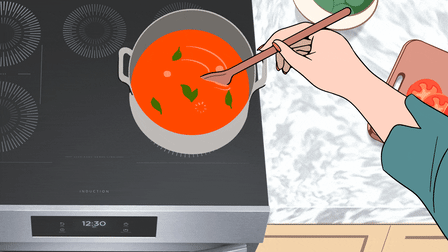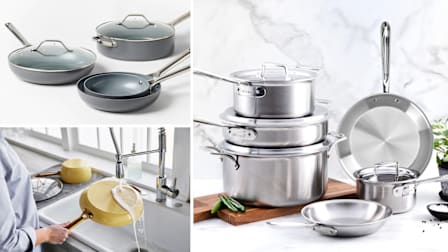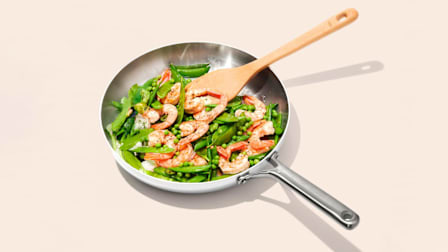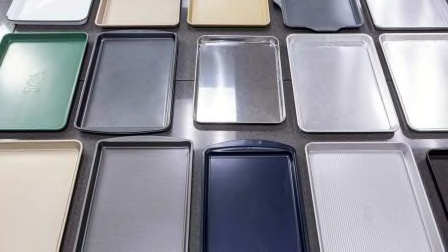Skip the Cookware Set. Here are the 5 Pieces You Really Need in the Kitchen.
Before spending hundreds on a bunch of pots and pans, consider your storage space and cooking style
When you shop through retailer links on our site, we may earn affiliate commissions. 100% of the fees we collect are used to support our nonprofit mission. Learn more.
Cookware sets tend to include a stock pot, saucepans, and frying pans. But some pieces may not get as much use as others—or you may not use them at all. So is it worthwhile to buy a full set? We asked our in-house experts, as well as pros from America’s Test Kitchen, Food 52, and the DeGustibus Cooking School, to recommend must-have gear for any home kitchen.
The Basics
These five items are all most home cooks need for cooking and baking.
Saucepan
Look for one that’s 3 to 4 quarts. “It’s not just for sauces,” says Kristen Miglore, founding editor of Food 52’s Genius Recipes. “In a lidded saucepan, you can steam rice and vegetables, boil pasta and potatoes, cook soups and oatmeal and polenta and tomato sauce. Some days, you might even wish you had two.”
Nonstick skillet
“For delicate ingredients like eggs and fish, nonstick pans will save you a lot of stress—and dinner that would otherwise be lost to the pan,” Miglore says. Select a size depending on your family and needs. Miglore has three: an 8-inch (“for eggs for my toddler”), a 10-inch (“for eggs for the whole family”), and a 12-inch (“for salmon fillets”). Below, members can see three top-rated nonstick frying pans from our tests.
Cast-iron frying pan
These are super-versatile and last for generations. When Consumer Reports’ test engineers evaluate cast-iron pans, they bake cornbread and sear steaks. But you don’t have to stop there. You can transfer a cast-iron skillet from the stovetop to the oven when you’re cooking pork chops or any other thick cut of meat. Or use it to bake deep-dish pizza. Delicious. Here are our top three: two uncoated and one coated.
Dutch oven
Salvatore Rizzo, owner and CEO of the DeGustibus Cooking School in New York City, owns five Dutch ovens. (“I have a lot of cookware,” he admits.) His favorite? The 7½-quart Le Creuset. “Seeing how evenly it cooks always makes me smile,” he says.
In our Dutch oven tests we brown meat, bake bread, simmer tomato sauce, and time how long it takes to bring 4 quarts of water to a near-boil. A Dutch oven can do all those things for you, which means you don’t need a stockpot to make soup or boil pasta.
But the sweet spot for Dutch ovens is braising—cooking low and slow in the oven for hours. That’s the secret to turning a tough cut of meat, like beef brisket, into a meal fit for a family celebration or just dinner. Another plus: If you have a Dutch oven, you really don’t need a slow cooker. Here are the top Dutch ovens from our tests.
Rimmed baking sheets
All of the experts we spoke with recommend getting one or more sheet pans, preferably at least one with a wire rack that nestles inside. That way you can use it in the oven for roasting or, when it’s cool, on the counter for cooling cookies or resting meat. “A true kitchen workhorse, sheet pans are handy for roasting whole chickens and all sorts of vegetables, toasting nuts, baking cookies, making toast under the broiler, sliding under cakes and pies to catch drips, and, famously, making entire sheet-pan dinners,” Miglore says.
Rizzo says you shouldn’t cheap out on sheet pans. “Buy from a professional kitchen store,” he advises. “You need the weight and depth, and it needs to be sturdy.” Miglore recommends looking for what’s called a half sheet or “jelly-roll size.” They’re 18x13 inches vs. the full-sized pans used in professional kitchens (18x26 inches), which are too big for most home ovens. The half sheet is the size typically called for in sheet-pan dinner recipes.
Uncoated sheet pans performed better in our tests overall than coated ones, primarily in the areas of cooking evenness and durability. Here are the top three uncoated sheet pans we tested.
If you prefer a coated sheet pan for easy cleaning, here are some top picks.
The Nice-to-Haves
While not essential, these four pieces of cookware can add convenience and help you expand your cooking methods.
Small saucepan
A 3- to 4-cup saucepan, often called a butter warmer, can be a nice complement to a larger saucepan. It’s often more efficient for boiling a few eggs, tempering spices, warming up soups, and preparing a small amount of boiling water, hot coffee, or scalded milk for baking, Miglore says. “And, as the name implies, for melting butter, instead of risking it exploding in the microwave,” she says.
Wok
Both McManus and Rizzo are big fans. “I use my wok for everything,” Rizzo says. McManus has tested them for America’s Test Kitchen and heartily agrees. She likes the high sides because, unlike a shallow skillet, the wok holds vegetables or whatever else you’re stirring without them tumbling out over the sides. McManus recommends a flat-bottom wok because it can be used on all types of stovetops, including gas, smoothtop electric, induction, and even electric coil burners.
Stockpot
While you can make soup or boil water for pasta in a Dutch oven, if yours is in rotation making the sauce for your pasta or other dishes, you might also want a stockpot, a piece that’s high on Rizzo’s list. But stockpots take a lot of space to store, so if you’re just starting out—or you’re tight on cabinet space—you can probably get by with just one large pot and a Dutch oven.
Carbon steel skillet
You may not be as familiar with carbon steel pans compared with cast-iron or nonstick. But as McManus says: “Carbon steel has some of the properties of cast-iron and some of the properties of nonstick. A little bit of everything.” For starters, they’re lighter than cast-iron pans but can do almost anything a cast-iron pan can do (although cast-iron performed better in our tests). And because they’re lighter-weight, it’s easier to transfer a carbon steel skillet from the stovetop to the oven.
If you’re worried that a carbon steel pan will be too difficult to care for, many come seasoned, a process in which oil is bonded to the pan, and like cast-iron, develops a patina over time that’s almost like a nonstick-like surface. It’s a win-win. Here are the top carbon steel skillets from our tests.
If You Really Want a Set
If you’re thinking about buying a set, look for one that doesn’t have a lot of extraneous pieces that will go straight into a drawer or cabinet.
In our ratings of cookware sets, we list every piece included. Click through to the individual sets and look under the heading “What’s in the Box” under "Specs" to see what’s in each set. If you see a cookware set that strikes your fancy, check the manufacturer’s website to see whether the individual pieces are sold separately. Many of them are. Here are three nonstick starter sets that include the essentials.
If you prefer a stainless set, here are our top three.
@consumerreports Your morning omelet deserves the best, which is why we hold nonstick pans to a high standard 🍳 See the best nonstick frying pans from our in-depth tests through the link in our bio. #foodtok #cookingtiktok #nonstickpans #nonstickcookware #kitchentok
♬ original sound - Consumer Reports





























